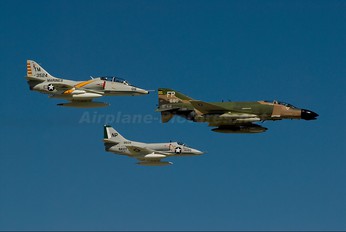

With the addition of a larger, more powerful radar in the nose the next version became the F-4D of which 825 were built. Sidewinders were used for close-range engagements while Sparrow missiles had a longer-range, but both were slowly being refined at the time and it was still a necessity to have an on-board cannon as many MiG engagements took place in what is considered close-in combat. Early versions of USAF F-4Cs, and later F-4Ds, operated in-combat were able to score many air-to-air kills against North Vietnamese MiGs using AIM-9 ‘Sidewinder’ and AIM-7 ‘Sparrow’ air-to-air missiles. Aerial guns were standard equipment on previous generations of fighters, but was considered unnecessary based upon the notion that future air-to-air combat would be conducted using air-to-air missiles exclusively.

The F-4 was intentionally designed without an on-board cannon for use in air-to-air combat or air-to-ground strafing. Work soon shifted back to the Ogden Air Logistics Center, Hill AFB, Utah or to in-theatre centers such as Clark Air Base, Philippines. The work at OC-ALC helped boost Air Force F-4 overhaul production numbers as F-4s were heavily involved in combat operations in Southeast Asia during the Vietnam War. There was also a short period of time, July 1970 to June 1972, when some depot level maintenance, overhaul and upgrades/modification were conducted as 101 F-4s passed through the Oklahoma City Air Logistics Center. Tinker played an important role in the sustainability of Air Force F-4s from the start through J79 engine maintenance and overhaul between Aug. The folding outer wing panels suited it well to carrier operations with the Navy and Marine Corps and in revetments with all services when conducting land-based operations during the Vietnam War.
#F 4D PHANTOM II PLUS#
The mach-two plus capable aircraft was originally designed as a Navy carrier-borne fighter/bomber and all version of the Phantom II have a robust tail hook between the engine nozzles, under the tail. For a fighter, the F-4 is a massive, heavy-weight hitter with a maximum take-off weight of 61,795 pounds. The jet sits on tricycle landing gear and has large air intakes for the jet engines with air controlled by variable-ramps at the intakes leading edge. The highly-swept, low-wing design has dihedral outer wing panels (up-turned) offset by horizontal stabilizers with an anhedral (down-turned) angle.

The F-4 has two cockpits in tandem for a pilot in the front seat and radar/navigator or weapon system officer in the back. For the most part, this article will focus on the versions operated by the Air Force, Air National Guard and Air Force Reserves. The Air Force’s initial version was the F-4C which first flew in 1963. First flown on May 27, 1958, the Phantom II entered service with the Navy, Marine Corps and Air Force. ReleasedGreg L.The McDonnell Douglas F-4 Phantom II is the most significant fighter aircraft of the 20th Century. Photo courtesy Don Jay.į-4D MiG-killer of 507th Tactical Fighter Wing, Tinker Air Force Base, Oklahoma This jet wears a Vietnam-era MiG-kill marking in the form of a red and yellow star on the intake splitter-plate. An F-4D Phantom II assigned to the 507th Tactical Fighter Wing, Air Force Reserves, Tinker Air Force Base, Oklahoma, shown on the flight line during a training deployment during the 1980s.The timestamp is only as accurate as the clock in the camera, and it may be completely wrong. If the file has been modified from its original state, some details such as the timestamp may not fully reflect those of the original file.
#F 4D PHANTOM II SOFTWARE#
This file contains additional information such as Exif metadata which may have been added by the digital camera, scanner, or software program used to create or digitize it.


 0 kommentar(er)
0 kommentar(er)
